|






BPE 2018 Bamako
MALI
Tel. +223 20217140
Fax: +223 20217140


| |
Interesting Places - Page 2
-
MOPTI
MOPTI located at the junction of the Niger and
Bani rivers, is called the Venice of Africa. The reality however is
considerably more chaotic-hundreds of colourfully painted “pinasses”
jostle each other, some more than 100 feet long and piled with every kid
of animal, vegetable and mineral. The air reeks of fish and other
interesting, but unidentified odours (salt, cola nuts, dried onions,…).
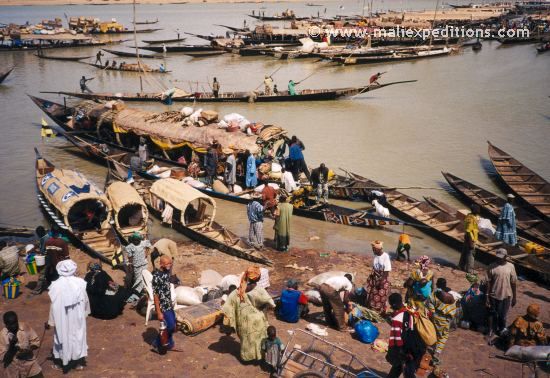
Located at roughly 650km from Bamako, the town originally developed as a
tiny Bozo village and knew great expansion toward the end of the XVIII
century. Today Mopti is the economic capital of Mali’s 5th region and is
starting/ending point of many tourist circuits.
Not to be missed: the Craftsmen’s Souk, the colourful market on the port
quays, the traditional districts, the “canoe-yard”, the teeming port,
the Komoguel Mosque (1933) and the sunset over the Bani.
-
THE DOGON COUNTRY
Unique site in Africa, land of legends and mysticism, the Land of the
Dogons is one o the last outposts of African ancient wisdom.
Entering this region is indeed like entering a temple. The comparison is
wild geographically, for the area occupies a plateau, which rises
chaotically from the low-lying Macina territory and culminates with the
famous Cliffs of Bandiagara, several hundred meters above the volcanic
plain.. Yet the analogy is also apt because when you enter the Dogon
country, you have to accept the radical strangeness of a cultural
universe whose values rest on an extraordinary rich and complex
philosophy and religion.

Whereas Djenne and Timbuktou have been known to Europe for centuries,
the Land of the Dogons has only been studied from 1931 with the
ethnological mission led by Prof. Marcel Griaule. The material and
cultural universes are both of quite difficult access. Everything in
fact, even the most banal objects, have a sacred character and carry
symbolic value. Even the shape of the humble Dogon Basket is symbolic:
its square bottom evokes the cardinal points while its circular top
refers to the celestial vault.
The “Dogon cosmogony” as it was explained by the old blind hunter
Ogotemmeli to Griaule is recounted in the book “Dieu d’eau”.
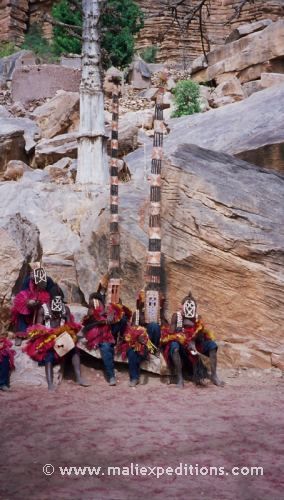 It is
indeed of great help in understanding the life of these incredible
people whose secret is their faith: the permanent presence of a belief
which accompanies every action of their day-to-day existence. The sacred
is inextricably mingled with reality. The extremely complex Dogon myths
constitute the very basis of existence, and religion leaves its mark
strongly even on the village architecture. It is
indeed of great help in understanding the life of these incredible
people whose secret is their faith: the permanent presence of a belief
which accompanies every action of their day-to-day existence. The sacred
is inextricably mingled with reality. The extremely complex Dogon myths
constitute the very basis of existence, and religion leaves its mark
strongly even on the village architecture.
From the top of the Cliff a good idea of Dogon style can be obtained.
The village is a mosaic of family dwellings called “guinna”, featuring
square terraces and millet granaries with pointed straw roofs. In
respect to its organization and lay-out, each village is arranged so as
to represent a human figure (anthropomorphic architecture), and
considering the high number of sacred places is actually a temple
proper. One can hardly take ten steps without encountering an altar or a
rock bearing traces of chicken blood. Neither can one fail to notice the
house reserve for menstruating women; it is round and set apart from
other dwellings, for the community must have no contact with “impure”
women. Then there are the “toguna”, buildings where men hold their
meetings and councils. Each is supported by 8 pillars (the 8 primitive
ancestors) and has a very low ceiling. There are shrines where the
mysterious rites of the Binou cult are celebrated and Amma, the creator
of all things, is worshipped. The temples facades are periodically
ornamented with symbolic geometric designs, the equivalent of actual
writing. Building space is very scarce, yet no cliff-dwelling Dogon will
be persuaded to buit on the plain because this is considered “dangerous”
and also reserved for crop cultivation.
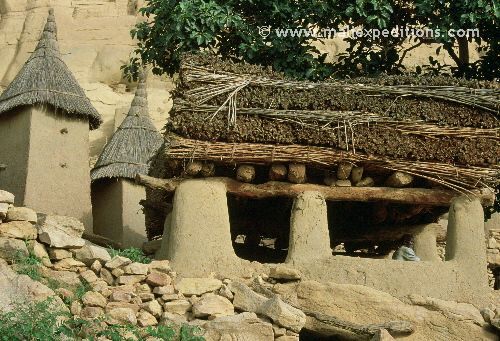
All inhabitants live from birth to death in close symbiosis with their
mineral universe. When they die, their bodies are wrapped in chequered
blankets and are hoisted into cavities in the rock. A few meters below
these aerial cemeteries, the living spend their days cultivating their
fields (millet on the “unsafe” plains, and onions near their dwellings)
and raising their sheep and goats. The Dogon myth is a living thing and,
even though not everybody possesses it to the full, all Dogons know
perfectly well which beliefs are attached to particular clothing,
carvings, skin scarifications and teeth-filing. The teeth are filed so
as to resemble the teeth of a comb and thus evoke the loom: speech
issuing from between the teeth is a source of action which weaves the
world. The sculptures and bas-reliefs decorating doors and certain
buildings have the same functions as those in Middle Age Cathedrals:
celebration and instruction.
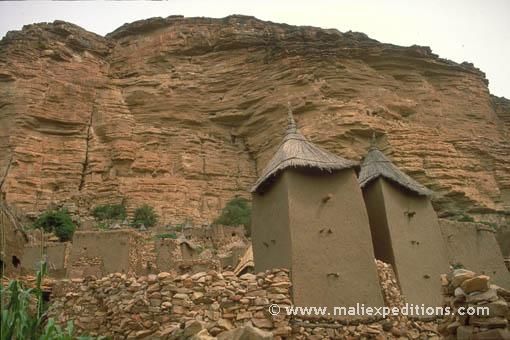
The master of all mysteries, the great initiate who directs certain
forms of worship and lays down the ceremonial rituals, is called the
Hogon and each village has this highest spiritual authority. He is the
oldest member of the community but it is his being the high priest of
Lébé (a primitive ancestor reincarnated as a snake) that confers every
strange peculiarities on him. Every night, according to the myth, a
snake comes and covers the Hogon with its saliva, granting him his vital
strength (as a consequence he must not wash). The same strength would
cause the ground to burn if he walked barefoot so he must always wear
sandals.
The Dogon profound attachment to their religion is seen most strikingly
in the dance of the masks. Originally, all dances in African tribes were
connected with religious rites but today most times the religious rites
but today most times the religious significance has been forgotten. Not
so among the Dogon. Dance is a serious business concerning men only and
no departure from the norm is allowed. For every dance – may are the
occasions demanding a ritual dance – the steps are as immutable as the
working of the universe, which they represent. Even the Dogon ballet,
featuring a variable number of masks (animals, girls, gods, the “storied
house”, the ythical Lébé serpent) and ceremonial.
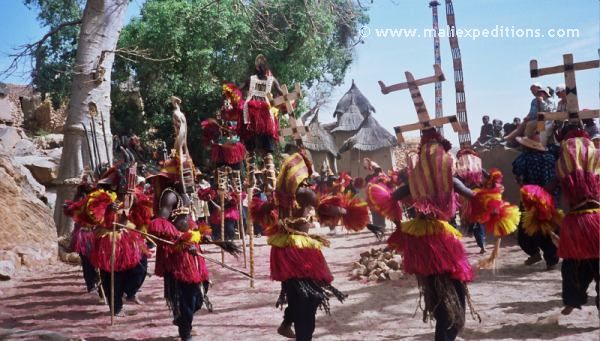
Markets are another experience not to be missed, but difficult to know
where and when because they are held every 5 days, as per the Dogon week
of 4 days of work and one of trading bustling activities and lots of
chatting, for talk is very important in Dogon society: “at the beginning
was the word”.
-
TIMBUKTU
Salt comes from north, gold from south and silver from the land of
Whites, but the Word of God, the famous things, histories and fairy
tales, we only find them in Timbuktu” (Sudanese proverb of the XVI
century).
What are the origins of this Malian city whose name immediately raises
enthusiasm and curiosity all over the world? Tombouctou, from the
Targuish word in Tinbouctou, means “the place of Bouctou”.
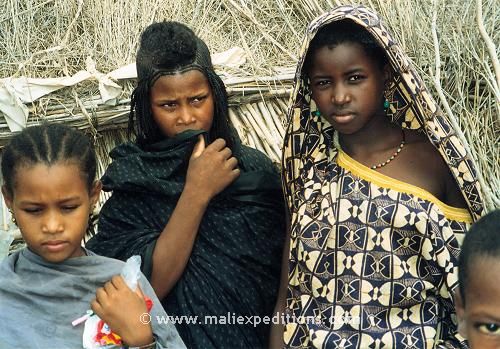
It was
founded in the XI century when the Imack-Charen Tuaregs, nomads who
spent winters in Azouad and dry seasons near the Niger, discovered this
small well slightly north of the riverbanks. When they left for the
north, they would leave some of their luggage behind with an old woman
to look after it. Bouctou was her name. Thus started a small village
that a few centuries later would become one of the most important and
famous commercial and religious centers of northern Africa.
Timbuktu was exceptionally well situated and this made it a first class
trade centre
When Emperor Kankan Moussa returned from his pilgrimage to Mecca in
1325, he had been so impressed by Cairo and the other holy cities
visited that he decided to transform Tombouctou: he ordered the
construction of Djingareiber Mosque and developed the already
flourishing commerce.
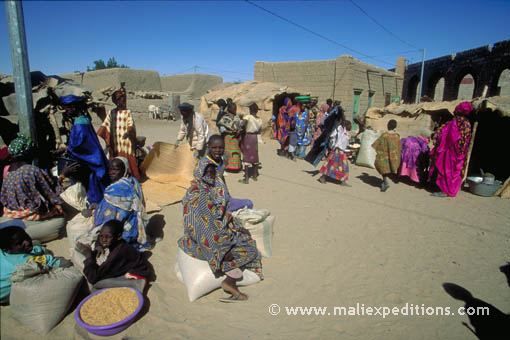
This was the golden age (XIV-XVI centuries) of the
town risen from the desert sands. In Tombouctou the White north met the
Black south and everything was traded: silk, spices, copper, tin, gold
ivory, ostrich feathers, slaves, salt, etc…Riches poured in and allowed
the blossoming of a very defined civilization centred around the art of
living. The hearts of the literary flourishing were the University and
Mosque of Sankoré. Timbultu’s history mirrors the rise and decline of
civilizations in the area. Central spot on the trade routes in medieval
times, when ancient Mali declined, Timbouktu was taken over by the
Fulani people and later by the French.
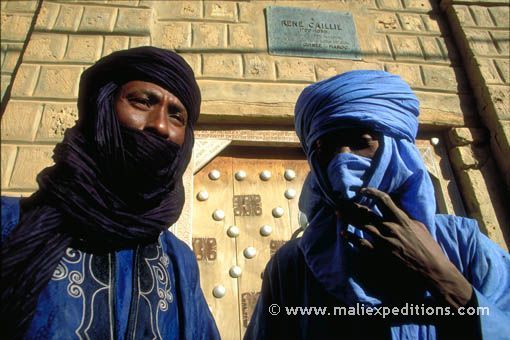
But the spirit of Tombouctou, its faith and its pride still mark the
inhabitants and its buildings: Djingareiber, Sankore and sidi Yahya
Mosques, the explorers’homes (Caillé, Barth, Mungo Partk and Laing), the
buildings built in the same style for centuries past, the Museum, the
Library, the market, the Azalai caravans,… UNESCO listed Timbuktu as a
World heritage site in 1988.
-
THE AZALAI
In bygone days, before maritime navigation replaced trans-Sahara caravan
routes, international trade was carried out overland. It was the time of
the “Silk Road” and of its twin sister, the “Salt and God Road” which
connected West Africa to the Mediterranean Sea. Timbuktuwas the main
inter-port, the last stop from which fabulous caravans led by mysterious
Touaregs left. Nowadays, of these legendary routes only memory remains.
However, the need for salt in West African countries has kept one of
these caravans alive, precisely the Azalai.
In the heart of Sahara, 800 km north of Tombouctou, a former lake dried
up millions of years ago leaving behind an enormous rock salt Once
extracted, the precious “White gold” is taken to the Niger to be later
distributed throughout the Sahel. This hard job is carried out by the
Tuareg who, from October to March organize camel caravans of 30 to 40
camels from Tombouctou to the Taoudenni salt mines. The journey lasts 20
days each way and each camel carries 4 to 6 salt bars of 30 kg.
The Azalai, which in Tamachek means “nostalgia for the return”, is the
last great most spectacular caravan of our epoch.
TRADITIONAL CELEBRATIONS
-
DOGON
every 4 years Dama to remember the
ancestors
every 60 years Sigui. All masks come out and go
around; the celebration moves around the
villages.
every 3 years Songho Circumcision Feast in March
(next 2006)
-
KANGABA
every 7 years Kaaba-Bolon when re-building the Malinke Holy Hut
-
LONTOU
end of harvest Mamadjombo
Kassonke mask dance
-
MOUDIAH
April-June Slaves Feast
to reaffirm unity and understanding between
slaves and masters
-
DIAFARABE
Nov.Dec.Transhumance
Transhumance of the Peulhs’livestock from
the south to the inner Delta
-
TIMBUKTU
Profet’s birthday Maloud.
the main Muslim celebration in Timbukty
-
MARKALA
June Puppet Feast
Carnival waiting for the rains
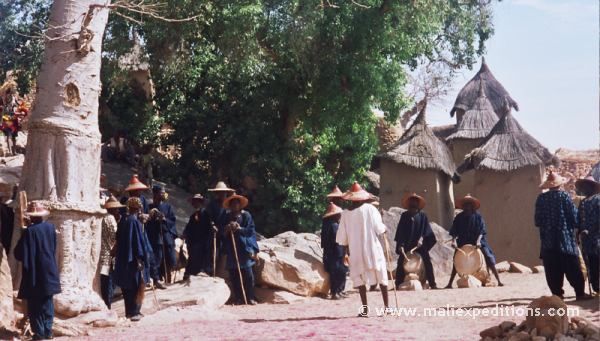
 
|
